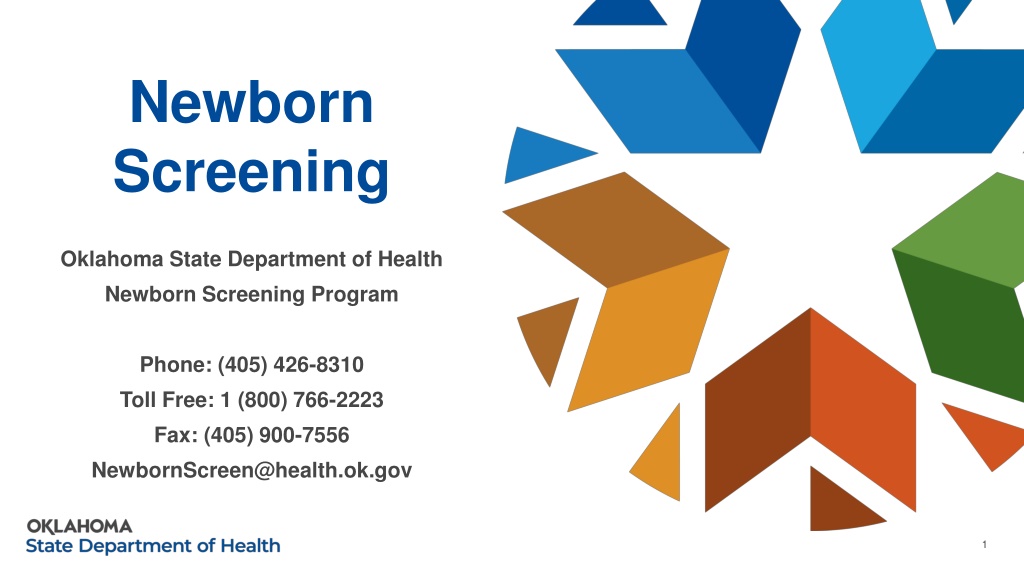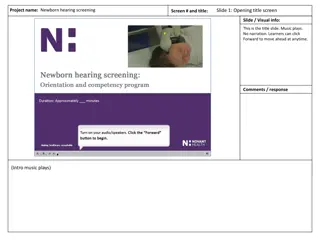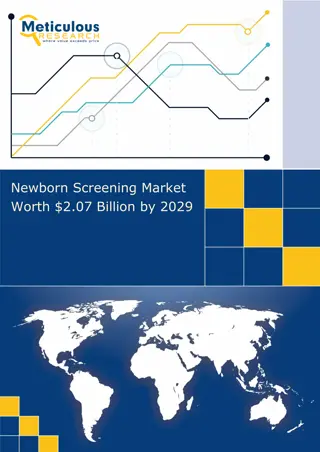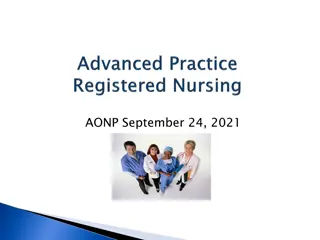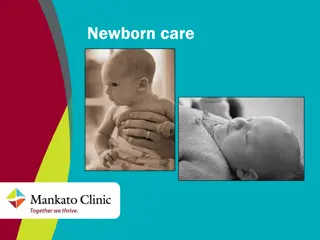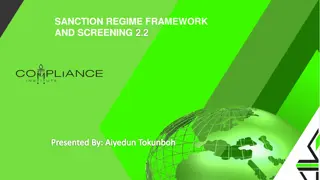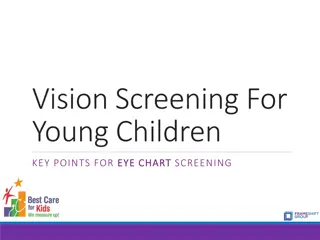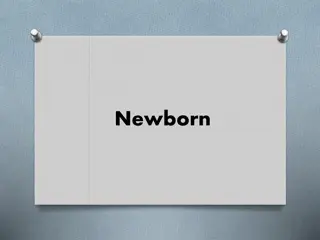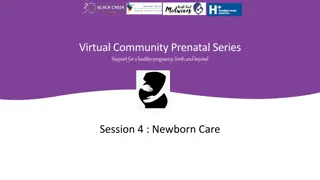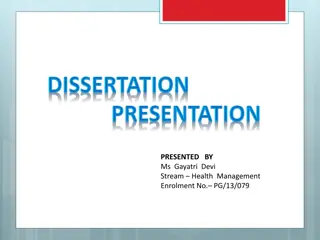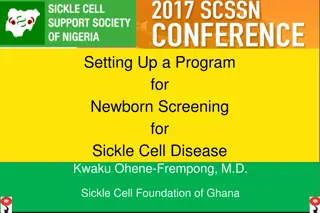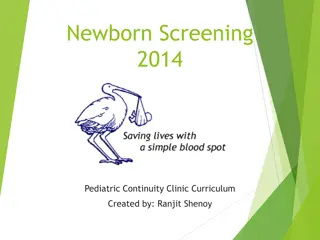Understanding Newborn Screening in Oklahoma
Newborn screening in Oklahoma is crucial for detecting hidden disorders in newborns that may not be apparent at birth. Early detection through screening can lead to timely treatment, ensuring healthy development and potentially saving lives. The process involves testing every newborn for harmful conditions, with decisions on screening panels following national guidelines. Education for parents is emphasized, highlighting the importance of providing accurate contact information for follow-up care. The program continuously expands to include more disorders, aiming to benefit newborns and families across the state.
Download Presentation

Please find below an Image/Link to download the presentation.
The content on the website is provided AS IS for your information and personal use only. It may not be sold, licensed, or shared on other websites without obtaining consent from the author. Download presentation by click this link. If you encounter any issues during the download, it is possible that the publisher has removed the file from their server.
E N D
Presentation Transcript
Newborn Screening Oklahoma State Department of Health Newborn Screening Program Phone: (405) 426-8310 Toll Free: 1 (800) 766-2223 Fax: (405) 900-7556 NewbornScreen@health.ok.gov 1
Newborn Bloodspot Screening Purpose Newborn screening (NBS) is the practice of testing every newborn for harmful or potentially fatal disorders that are not otherwise apparent at birth. Early detection and prompt treatment can make the difference between healthy development or lifelong impairment and possible death. Oklahoma State Department of Health | Newborn Screening Program 2
Screening vs. Diagnostic The newborn screen is just that a screen. Screening results, by themselves, cannot determine the presence or absence of a disorder. Diagnostic results refer to the combination of signs, symptoms, and test results that allows the doctor to confirm the diagnosis of a respective disease. Oklahoma State Department of Health | Newborn Screening Program 3
Who Decides? In 2022 the Oklahoma legislature passed statute stating that the Oklahoma NBS panel will match the national recommended uniform screening panel (RUSP) to the extent practicable. Once a condition is added to the RUSP the NBS Program (lab and follow up) will determine practicability and readiness. Then the Infant and Children's Health Advisory Committee will provide recommendations to the Commissioner of Health to add the disorder. The Commissioner of Health will give final approval. Oklahoma currently screens for over 50 possible hidden disorders. Oklahoma will continue to expand. Oklahoma State Department of Health | Newborn Screening Program 4
Autosomal Recessive Most NBS disorders are autosomal recessive with the exception of: Congenital Hypothyroidism (CH) Some forms of Severe Combined Immunodeficiency (SCID) X-Linked Adrenoleukodystrophy Usually no prior family history Risk for each pregnancy if both parents are a carrier of a disorder: Possible Outcomes for Offspring of Parental Disease Carriers Not affected Carrier Disease 25% 25% 50% Oklahoma State Department of Health | Newborn Screening Program 5
Parent Education NBS is collected on every baby born in Oklahoma. Importance of correct contact info & PCP for follow-up. No news is not good news! Update NBS Program with changes in home address and/or PCP. Review hidden disorders, using NBS pamphlet as a guide. Specimens are kept by the OSDH lab for 42 days before being destroyed. Explain that most affected newborns do not exhibit signs & symptoms early on. Prompt identification & treatment of disorders is critical. Oklahoma State Department of Health | Newborn Screening Program 6
Parent Education Instruct parents to ask for screen results on first visit to PCP. Tell parents to bring the Blue or Pinkslip to their baby s first doctor s visit. Oklahoma State Department of Health | Newborn Screening Program 7
Parent Education Review reasons why a repeat screen may be needed: Unsatisfactory Specimen Out-of-range results Possible disorder identified Hgb Trait condition Specimens collected less than 24 hours Risk for missing some disorders Premature or Sick Infants (TPN & antibiotics could affect results) Not collected prior to a blood transfusion Oklahoma State Department of Health | Newborn Screening Program 8
Filling out the Form Specimen testing will be delayed if the form is incomplete! Oklahoma State Department of Health | Newborn Screening Program 9
Filling out the Form Specimen testing will be delayed if the form is incomplete! Check expiration date If the filter paper is expired, discard the paper, and check the stock of filter paper kits and discard all expired kits. Collect the specimen on a kit that is not expired. Oklahoma State Department of Health | Newborn Screening Program 10
Filling out the Form: Specimen Information Specimen testing will be delayed if the form is incomplete! If this is the first specimen collected for the baby, check the First Screen box. If baby has had a previous screen, check the Repeat Screen box. List the previous OSDH Lab Number, if applicable. Oklahoma State Department of Health | Newborn Screening Program 11
Filling out the Form: Specimen Information Specimen testing will be delayed if the form is incomplete! If baby expires before a screen can be collected: Check the Expired box Enter the date that baby passed away Submit the filter paper form to the OSDH PHL Oklahoma State Department of Health | Newborn Screening Program 12
Filling out the Form: Specimen Information Specimen testing will be delayed if the form is incomplete! If baby is transferred prior to specimen collection: Check the Transferred box Enter the date that baby transferred and the facility that baby was transferred to It is the responsibility of the receiving facility to collect the newborn screen Oklahoma State Department of Health | Newborn Screening Program 13
Filling out the Form: Specimen Information Specimen testing will be delayed if the form is incomplete! Tests Requested: Check all that apply. All Tests- always check unless test is for HGB Only or Phe Monitor. This ensures the lab screens for all disorders on the NBS panel. HGB Only- Check if repeat screen is for follow-up of initial abnormal HGB result. GALT- Check GALT in addition to All Tests if there is a family history of galactosemia or if baby is on lactose-free (soy) formula at time screen is collected. Phe Monitor- Check only if baby has been diagnosed with PKU (typically metabolic specialists only) CFTR- Check in addition to All Tests if baby has clinical concerns for CF, meconium ileus, and/or family history of CF. Oklahoma State Department of Health | Newborn Screening Program 14
Filling out the Form: Infants Information Specimen testing will be delayed if the form is incomplete! Baby s first and last name (use legal name as displayed on the birth certificate). If baby s first name is unknown, BG or Female , BB or Male may be used. Oklahoma State Department of Health | Newborn Screening Program 15
Filling out the Form: Infants Information Specimen testing will be delayed if the form is incomplete! Sex/Gender Check Male , Female , or Unknown Oklahoma State Department of Health | Newborn Screening Program 16
Filling out the Form: Infants Information Specimen testing will be delayed if the form is incomplete! Date & Time of birth Enter the time using the 24 hour clock. For example 1PM would be entered as 13:00. Oklahoma State Department of Health | Newborn Screening Program 17
Filling out the Form: Infants Information Specimen testing will be delayed if the form is incomplete! Date & Time of specimen collection Ideal time for well, term newborn: 24 hours + 1minute of age Enter the time using the 24 hour clock. For example 1PM would be entered as 13:00. Oklahoma State Department of Health | Newborn Screening Program 18
Filling out the Form: Infants Information Specimen testing will be delayed if the form is incomplete! Medical record number Baby s medical record number Oklahoma State Department of Health | Newborn Screening Program 19
Filling out the Form: Infants Information Specimen testing will be delayed if the form is incomplete! Gestational Age List gestational age at birth. Lab cut off values for abnormal severe combined immunodeficiency (SCID) are gestational age dependent. Oklahoma State Department of Health | Newborn Screening Program 20
Filling out the Form: Infants Information Specimen testing will be delayed if the form is incomplete! Birthweight (in grams) Lab cut off values for abnormal congenital adrenal hyperplasia (CAH) results are dependent on birth weight. Oklahoma State Department of Health | Newborn Screening Program 21
Filling out the Form: Infants Information Specimen testing will be delayed if the form is incomplete! Birth order (if multiple birth is present) Indicate A , B , C , etc. if baby is of multiple birth (twin, triplet, etc.). Do NOT mark anything in this space if baby is a single birth. Oklahoma State Department of Health | Newborn Screening Program 22
Filling out the Form: Moms Information Specimen testing will be delayed if the form is incomplete! DHS Custody or Adoption Note: If baby is adopted, be sure to check the Adoption box on the filter paper form and enter the agency/law firm information in this section. If DHS is involved, enter case worker information in this section and check the DHS Custody box. Oklahoma State Department of Health | Newborn Screening Program 23
Filling out the Form: Moms Information Specimen testing will be delayed if the form is incomplete! Mom s first and last name Mom s mailing address: Street, Apt # (if applicable), City, State, Zip Mom s telephone number: Extremely important to include in case newborn screen results are abnormal and require follow-up. Oklahoma State Department of Health | Newborn Screening Program 24
Filling out the Form: Providers Information Specimen testing will be delayed if the form is incomplete! Physician Ordering the NBS: Include first and last name Enter the NBS Provider ID #, if known If Provider ID # unknown, document name and phone number Oklahoma State Department of Health | Newborn Screening Program 25
Filling out the Form: Providers Information Specimen testing will be delayed if the form is incomplete! Primary Care/Follow-up Physician: Planned health care provider upon discharge from birthing facility Include first and last name Enter the NBS Provider ID #, if known Extremely important that this is correct in case newborn screen results are abnormal and require follow up Oklahoma State Department of Health | Newborn Screening Program 26
Filling out the Form: Medical/Feeding History Specimen testing will be delayed if the form is incomplete! Check all that apply for baby at the time of specimen collection If transfused enter the date and time of transfusion NICU/Special Care Nursery TPN/SNAP Lipids/Carnitine/MCT Lactose-Free (Soy) Formula Meconium Ileus Family History of Cystic Fibrosis (CF) Oklahoma State Department of Health | Newborn Screening Program 27
Filling out the Form: Submitter ID Specimen testing will be delayed if the form is incomplete! Submitting Health Provider ID # This is the ID of the provider/facility who collected the specimen Write or stamp in facility name and address Oklahoma State Department of Health | Newborn Screening Program 28
Filling out the Form Specimen testing will be delayed if the form is incomplete! Unsatisfactory Specimen Follow-up Specimen collectors can place their initials and unit in the area below for identification purposes, in the event of an unsatisfactory specimen. This allows for easier identification of the individual who collected the specimen so that further education and/or training can be provided. Note: Do not touch the filter paper in any other area when writing initials and unit. Oklahoma State Department of Health | Newborn Screening Program 29
Collecting the Specimen Oklahoma State Department of Health | Newborn Screening Program 30
Time of Screening: Healthy Newborn 24 hoursplus one minute of age Or Prior to discharge **WHICHEVER COMES FIRST** Oklahoma State Department of Health | Newborn Screening Program 31
Time of Screening: Premature or Sick Newborns Oklahoma State Department of Health | Newborn Screening Program 32
Specimen Collection Heel Stick / Direct Application Preferred, recommended method Start with clean, dry hands before handling the filter paper. Oklahoma State Department of Health | Newborn Screening Program 33
Direct Application Prepare the Site Warm the heel with a heel warmer or a soft cloth, moistened with warm water up to 41 C for 3 to 5 minutes. Warmth leads to vasodilation, which increases bloodflow and chance of collection success. *Follow your hospital protocol regarding which warming device to use* Oklahoma State Department of Health | Newborn Screening Program 34
Direct Application Prepare the Site Encourage skin-to-skin contact between newborn and parent during specimen collection. Decreases stress response in newborn Encourages bonding Position the infant s leg lower than the heart. This increases venous pressure, which results in increased blood flow and a greater chance of collection success. Wearing gloves, wipe the infant s heel with 70% isopropyl alcohol. Allow the heel to air dry! Residual alcohol can affect NBS results and/or lead to unsat specimens. Oklahoma State Department of Health | Newborn Screening Program 35
Direct Application Lancet Placement Hatched areas are safe for puncture Damage to nerves and/or the heel bone may occur for punctures outside of the hatched region. Oklahoma State Department of Health | Newborn Screening Program 36
Direct Application Perform the Puncture Using a sterile lancet, perform the puncture. Gently wipe off the first drop of blood with a sterile gauze or cotton ball. Apply gentle pressure with thumb and around heel but not near the puncture site; ease intermittently as drops of blood form. Avoid milking the puncture site. Oklahoma State Department of Health | Newborn Screening Program 37
Direct Application Application Gently touch the filter paper card to the blood drop and fill each printed circle with one large drop of blood. Apply blood to one side only. Observe the saturation of each printed circle as the blood flows through the filter paper. Oklahoma State Department of Health | Newborn Screening Program 38
Alternative Specimen Collection What about capillary tubes? Not preferred Higher risk for collection error Anti-coagulants If used, must be sterile/clean & plain. No additives! Must be anti-coagulant free. However no anti-coagulants = risk for clotting - EDTA, citrate, & heparin - interfere with test results! Risk of scratching the filter paper. Avoid touching the capillary tip to the paper. Use a new tube for each pre-printed circle. Oklahoma State Department of Health | Newborn Screening Program 39
Alternative Specimen Collection What about venous samples? Discouraged May be appropriate under certain circumstances (e.g. NICU). More invasive than a heel stick. Do not draw blood from extremity with infusing IV fluids. Please refer to current CLSI guidelines for more information. Oklahoma State Department of Health | Newborn Screening Program 40
Alternative Specimen Collection What about umbilical catheters? Discouraged May be appropriate under certain circumstances (e.g. NICU). Ensure the line is cleared by withdrawing 2 2.5 cc (mL) of blood prior to collection a specimen for NBS. Please refer to current CLSI guidelines for more information. Oklahoma State Department of Health | Newborn Screening Program 41
Alternative Specimen Collection What about umbilical cord blood? Discouraged May be appropriate under certain circumstances (e.g. NICU). Risk for maternal blood contamination. Repeat the newborn screen using the heel stick method when indicated. Please refer to current CLSI guidelines for more information. Oklahoma State Department of Health | Newborn Screening Program 42
Specimen Collection: What NOT to Do Do NOT dab or color in the filter paper circles. Do NOT apply multiple drops of blood per circle. Do NOT scratch the filter paper. Do NOT contaminate specimens. insufficient drying of alcohol, oils on hands, lotions, compressing the circles, spills, etc.. Do NOT stack specimens. risk for leaching & cross-contamination between specimens Do NOT submit wet specimens. Do NOT place specimens in direct sunlight or in front of air vents or other sources of moving air. Do NOT place specimens in plastic bags. Do NOT batch (hold onto) specimens. Oklahoma State Department of Health | Newborn Screening Program 43
Pre-collection: Check the Expiration Date of the filter paper If filter paper is expired, discard the paper, check the stock of filter paper kits it came from to ensure they are not all expired, and collect on a kit that is not expired. Post-collection: Air dry specimen horizontally for 3-4 hours Transporting wet specimens can make them unsatisfactory for testing. Send specimen with Courier within 24 hours of collection Delayed receipt of specimens to the Public Health Laboratory can delay identification of and treatment for a disorder, which can result in lifelong disability or even death for Oklahoma newborns. Know the courier schedule and location for your facility! Ensure all staff involved in newborn screening are also aware of the process. Maintain specimen collection log & ensure screening results are received & recorded Ensure that everybody who handles the filter paper or is involved in the newborn bloodspot collection process is trained Oklahoma State Department of Health | Newborn Screening Program 44
NBS Filter Paper Review Unsatisfactory ( Unsat ) Specimen Examples Oklahoma State Department of Health | Newborn Screening Program 45
Filter Paper The filter paper is part of the NBS Form. It is a medical device designed to absorb a specific volume of blood within each pre-printed filter paper circle. If an analyte for any disorder is either too high or too low, this is an indication that additional testing is needed. Accurate results depend upon proper absorption of blood onto the filter paper. Too much or too little blood may result in inaccurate results. Oklahoma State Department of Health | Newborn Screening Program 46
Multiple Application Front Back Why Unsat? When bloodspots overlap or touch, as is the case in the sample above, it creates an uneven absorption of blood. Analyte levels cannot be accurately measured. Testing these specimens will result in inaccurate results. Oklahoma State Department of Health | Newborn Screening Program 47
Clotted or Caked Blood Front Back Why Unsat? Clots can occur using capillary tubes or if too much blood is applied to the pre-printed circles. Samples with clots are not suitable for testing. Oklahoma State Department of Health | Newborn Screening Program 48
Serum Rings Front Back Why Unsat? Notice the halos around the periphery of most of the pre-printed circles above. This can occur due to the following: Insufficient drying of alcohol on the baby s heel prior to heelstick Drying the specimen vertically instead of horizontally Closing the flap of the filter paper on top of the circles while the specimen is still wet Placing wet specimens in plastic bags Milking or squeezing the puncture site Oklahoma State Department of Health | Newborn Screening Program 49
Inadequate Amount of Blood Front Back Why Unsat? The above filter paper circles are not sufficiently filled with blood for testing. Oklahoma State Department of Health | Newborn Screening Program 50
